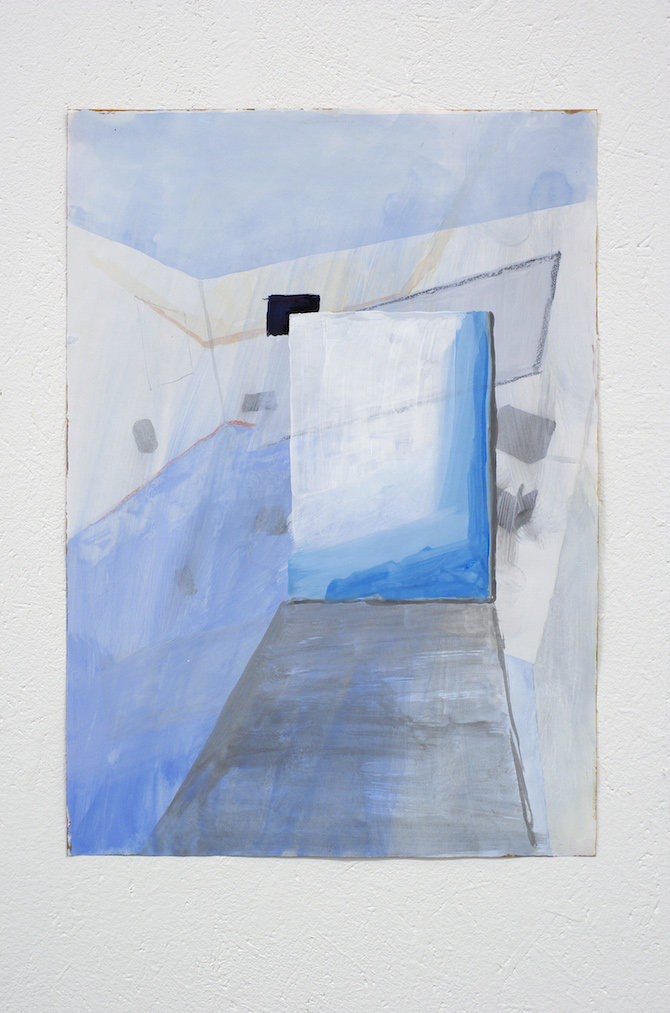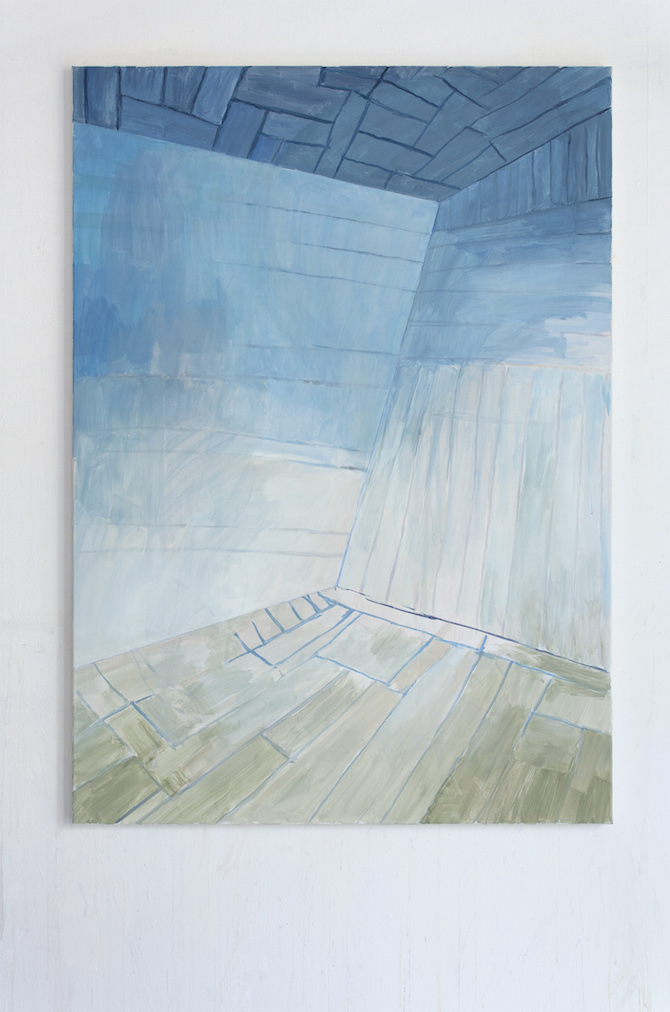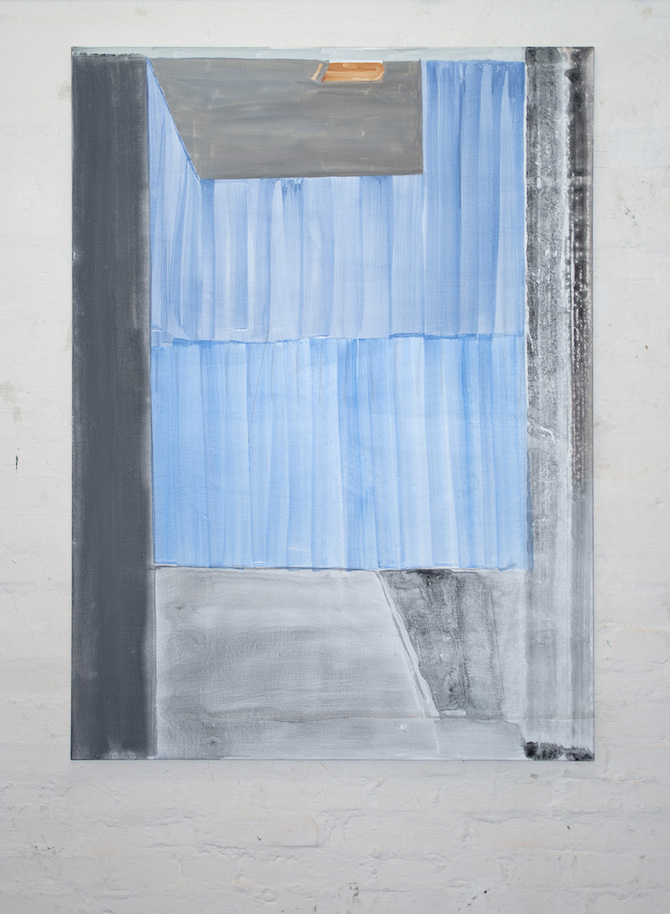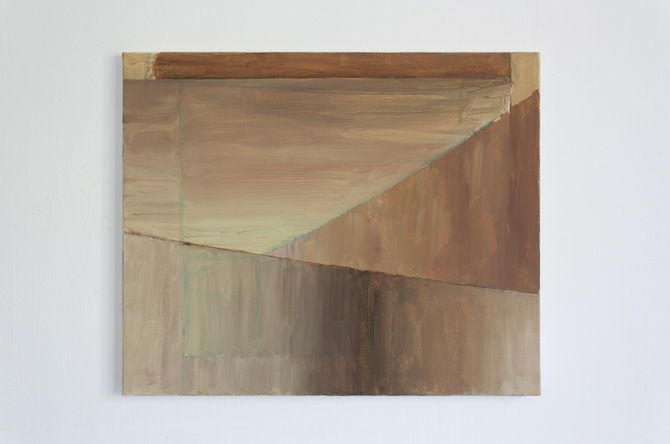
all works by Tobias Buckel, courtesy the artist and Peter von Kant gallery, London
The German artist Tobias Buckel uses the medium of paint to decipher its own codes: His works negotiate both the functions of space and of displays, often referring to the painted image as an instrument (and not only as an object) of representation. This is particularly interesting, since he studied communication design previous to his education in art in Nuremberg and at Chelsea College of Art and Design in London. Tobias' trained eye for graphical and architectural aesthetics, sharp lines or perspectives have a large impact on his practice and the work's overall appearance. While three dimensional and geometric shapes, and flat cubes dominate the motifs, they appear in both abstract and representational forms. These are often washed down and thin layered, superimposed and eventually merged into each other like a jigsaw. I spoke to the Nuremberg-based artist, who has an exhibition opening this Friday the 26.06 at Peter von Kant gallery in London, about his inspiration and his idea of abstract qualities.
Anna-Lena Werner: Do you look at your paintings as one work-in-process or as individual series?
Tobias Buckel: They are a work-in-process. Some themes or motifs do recur and I like seeing works from different times set in relation to each other.
Anna-Lena: One of these themes is the geometric and graphical form. What kind of space do they suggest in your paintings?
Tobias: They describe a transitional space that is rooted somewhere between figuration and abstraction. I often have an idea of something figurative when I start with a new painting. This can be a picture, a certain shape or even a concept or a word that I am interested in. During the working process I try to get rid of these cognitive thoughts and ideas.
Anna-Lena: Can you make an example of a picture or a word that has been relevant for you?
Tobias: There are many paintings that derive from pictures of interior spaces and stage settings, and others that started with the words "panel" or "display".
Anna-Lena: Why is it necessary to get rid of them?
Tobias: As long as I have concrete ideas in my mind, the paintings are just illustrations of my thoughts. It gets interesting, when I give up control and let things happen that I couldn't have thought of before. I am more interested in the abstract qualities of a painting than in narrative structures.
Anna-Lena: One of the abstract qualities in your paintings are the colours, which range from heavy dark browns to bright pastel pink tones. How do you pick them?
Tobias: My use of colour has become pretty much intuitive and the tones often stay within a scheme that reflects my personal taste at a time. The new ones have a lot of blue and grey tones – they appear more graphical.
Anna-Lena: Your application of paint is extremely thin, often even revealing several previous layers. Why do you choose to make the history of the work visible?
Tobias: This is my pondering working process. I start something with a few brushstrokes, then add some decisions, wash them off or paint them over again. I often let canvases rest for some days or even weeks before I go on.
Anna-Lena: Do you choose the materials intentionally or instinctively?
Tobias: I mix different materials intentionally, but the range of mediums is carefully selected. For example, after using oil and turpentine for a while, I experimented with using water-based paint that worked even better for a thin and washy application. In some new works I tested mixing paint using pigments, glue and acrylic binder, which is somewhere between acrylics and gouache, and I can still wash it off with a lot of water.
Anna-Lena: Not only spaces, also depths play a major role in your paintings. What made you choose the medium of paint and not, say, sculpture?
Tobias: Painting feels most natural to me. With a pencil or a brush I am able to formulate what I want to say. I tried other media during my studies, like video or sculpture, but I didn't want to deal with the third or fourth dimension. Paintings have a virtual quality that fascinates me. Although it is flat, you can create the illusion of space or experience something that is not really there.
Anna-Lena: You play with light and shadow – perhaps one of the few traditional and figurative elements left in your paintings. If you think about painterly traditions, who inspired you in the beginning of your career?
Tobias: I used to be excited about really painterly stuff – abstract expressionism and some CoBrA artists like Asger Jorn. But in retrospect, I think that Sigmar Polke was most influential. I was around eighteen at that time – quite a while before I studied art. I come back to his work from time to time. There is still something about it that I don't understand.
Anna-Lena: Both Polke and the CoBrA artists used a sense of playfulness in their art – has that aspect also grown on you?
Tobias: Yes, maybe. I wanted to work with a variation and add the lightness that I reach in my paper works also to some of my paintings.
Upcoming exhibition
Tobias Buckel
26.06 - 31.07.2015
Peter von Kant
25 Tanners Hill
London SE8 4PJ
Opening Hours: Thursday to Saturday 12–6pm
Also see










all works by Tobias Buckel, courtesy the artist and Peter von Kant gallery, London
